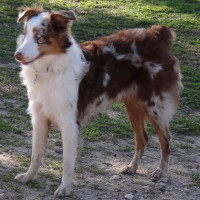Appearance of the Texas Heeler
|
| The Texas Heeler is a medium-sized dog. It's worth noting that it often has the curled tail of its parent breed, the Australian Cattle Dog. Texas Heelers come in a variety of colors and coat variations. It generally has a short to medium-length coat, from 2.5 to 7.5 centimeters in length. Its coat is generally smooth and soft. It often resembles the Australian Cattle Dog, but its color can vary. It can be black, blue merle or blue ticked. It may have some white or tan trim, especially on the feet and legs. They usually have the straight ears of their Australian Cattle Dog parent, but may inherit the folded ears of the Australian Shepherd Dog. |
Temperament of the Texas Heeler
|
| The Texas Heeler is a highly intelligent dog. That's why they're easy to train. He'll watch you constantly for clues and signals. He also has natural herding instincts, which can sometimes be a challenge for him. He is affectionate with his family and very protective too. He can be aloof with strangers and keep them away from you to protect you. We recommend giving the Texas Heeler a good dose of early socialization to teach him how to behave with his family and with strangers. He's an excellent watchdog, but he may not bark much, except in the presence of a stranger. Although he gets on well with children, he may bite and nag them from time to time. He is not, however, recommended for homes with other dogs or pets. |
Needs and activities of the Texas Heeler
|
| The Texas Heeler is a very energetic working dog. He really enjoys having a job to do. He loves learning tricks and commands, and may enjoy participating in agility and flyball activities if he's not assigned to farm or ranch work. Don't forget that he was born to herd cattle, and he won't waver from this instinct. He enjoys any kind of exercise, especially a thirty-minute walk twice a day. However, the best exercise for the Texas Heeler comes from simply running freely outdoors. The Texas Heeler will appreciate outings to the dog park. He'll especially appreciate being taken to an off-leash area where he can play freely. He'll love joining you for hikes on any type of terrain. The Texas Heeler will enjoy any outdoor family activity. |
Maintenance of the Texas Heeler
|
| The Texas Heeler is a low-maintenance dog. Its coat is often quite short and smooth. However, as it can have the longer coat of the Australian Shepherd, you may need to brush it weekly to prevent tangling or matting. Only bathe him when necessary. Note: it's important to remember that the Texas Heeler can be sensitive to touch. This means you need to establish a grooming routine with him from an early age so he knows what to expect. Brush his teeth two or three times a week to prevent bad breath and tartar build-up. However, if you want to prevent tooth decay, brush his teeth daily. Trim his nails every two weeks, unless he wears them down naturally. If he has straight ears, you should only clean them when you bathe him. If his ears are folded, you'll need to clean them with a damp cotton pad, perhaps every week. Wipe his ears with the cotton and check for any redness or odours. If you notice any of these symptoms, your dog could be suffering from an ear infection. |









 English (United Kingdom)
English (United Kingdom)